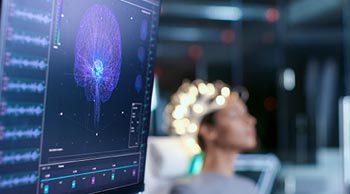Oneida Health
What is an Electroencephalogram
 An electroencephalogram or EEG is a test that uses small electrodes to detect electrical activity in your brain.
An electroencephalogram or EEG is a test that uses small electrodes to detect electrical activity in your brain.
Why the Test is Performed
An EEG detects anomalies in brain waves and can be used to diagnose many brain disorders including epilepsy, brain damage from head injury, brain tumor, brain dysfunction, inflammation of the brain (encephalitis), sleep disorders, and stroke. There are three types of EEGs: Standard, Ambulatory, and Video.
How to Prepare for the Test
- Avoid caffeine for 4-8 hours prior to the test.
- Take all other medications as usual, unless otherwise directed.
- Eat and drink normally.
- Your doctor will advise you on how much sleep to get prior to the test if you are expected to sleep during the test.
- Wash your hair the night before, but do not use any conditioners, hair creams, sprays, or gels. Sticky hair products can make it harder for the electrodes to adhere to your scalp.
What to Expect During the Test
- The test is painless and you will not experience any discomfort. Your doctor may have you sedated for the test, or you may remain awake.
- The technician will measure your head and mark the locations where the electrodes will be placed.
The technician adheres the electrodes to your scalp using a special adhesive. The electrodes are connected with a wire to a machine that will record your brain activity. - The EEG will last about one hour. Testing for certain conditions will require you to sleep during the test, in which case, the test will last longer.
- You relax with your eyes closed during the test. The technician might ask you to open and close your eyes, read a paragraph, perform a few simple calculations, look at a picture, or breathe deeply.
- If you are having a video EEG, your body motions are captured with a video recording during the test. This will help the doctor diagnose certain issues.
- The technician removes the electrodes.If you had no sedative prior to the test, you may resume normal activity. If you used a sedative, you will need someone to drive you home.
What the Test Results Show
Your doctor can use the results to detect anomalies in your brain waves and determine whether you have had a stroke or other brain dysfunction.
Potential Risks of the Test
The EEG is a noninvasive test. You will not experience any discomfort.